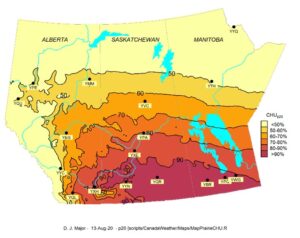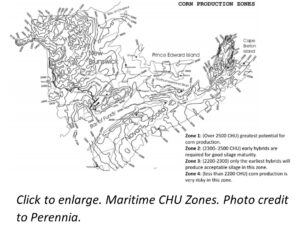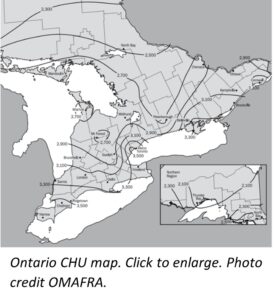Tips to Select Corn Silage Hybrids Across Canada
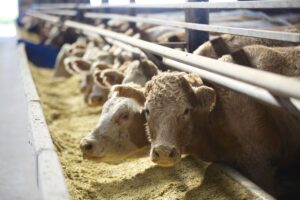
When grown and harvested properly, corn silage can be an excellent source of energy and fibre for beef cattle. Selecting a corn hybrid starts by determining your intended end use for the product. Are you planning to use corn silage as feed for mature cows or as part of a complete ration for feeder cattle? The answer to this question can change the variety of corn that producers should select. For example, if the silage will be used as a winter feed source for the cow herd, a higher energy corn variety may be better suited than a high fibre variety that would be used in a feeder ration where corn silage is used as a fibre source.
Much of Canada is suited to cool-season plants, but plant breeding companies have developed corn hybrids that require fewer corn heat units (CHU) during the growing season. The minimum CHU rating for corn hybrids has fallen from 2300 to 2000 over the past 40 years.
Once the end use is established, a corn hybrid may then be selected based on the available CHU for a specific location. CHUs indicate the number of accumulated thermal units over the growing season. CHU zones in Canada are mapped according to the growing season and long-term weather data. Silage corn hybrids can have grain maturity ratings 100 to 200 CHU less than corn grain varieties because corn silage is harvested at a lower dry matter content before the grain is fully mature.
The following are tips and tricks for selecting corn hybrids for regions across Canada from east to west.
A CHU map is an average of the heat units that can be expected and is not a guarantee for each year.
Selecting Hybrids in Western Canada
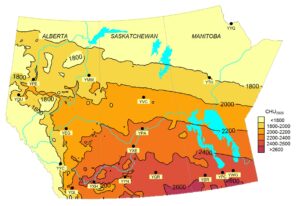
In recent years, the percentage of acreage seeded to corn has increased significantly in western Canada.
Dr. Karen Beauchemin is a research scientist who studies ruminant nutrition and the environment at the Agriculture Agri-Food Canada research station in Lethbridge, Alberta. She has studied CHUs extensively and has noticed a shift over time.
A CHU map is an average of the heat units that can be expected for a region and is not a guarantee for each year. During a recent hybrid trial, Dr. Beauchemin’s research suggested that the CHUs were higher than what was previously indicated for the Canadian prairies. Unlike the previous CHU map developed in 1976, this new map reveals that the growing season may be longer on average than previously thought. This doesn’t suggest that the growing season is warmer, but there are more warm days than in years past.
Selecting a hybrid that will reach the desired maturity during the growing season in your area is key. Dr. Beauchemin says plants that are immature at the first heavy frost can result in a crop with very high dry matter content. This can make the corn difficult to turn into silage since the optimum moisture content is around 60 to 68%.
Determining the CHU rating for a corn hybrid is not an easy or quick process. Dr. Beauchemin suggests that producers ask their seed company for trial data closest to their location for the varieties they are interested in to help make a decision.
- Maximize photosynthesis by using uniform planting depth and increase seeding density (slightly more than for grain yield).
- Use the entire growing season within your CHU zone.
Hybrid selection example:
The CHU map above shows the long term expected ranges in CHU. It is important to understand that these are long term averages, and year to year differences in actual CHUs obtained can vary tremendously. Most years vary from the average by 200 CHU. For example, Saskatoon (YXE) can anticipate 2300 to 2500 CHU for the growing season on average, but to ensure maximum yield as well as quality, a producer could select hybrids with a rating of 2100 to 2300 CHU. In Saskatoon, there is an 80% probability of obtaining 2100 CHU in a given year, but only a 55% probability of obtaining 2300 CHU. In the Edmonton (YEG) region with a long-term average of 2000 to 2200 CHU, a producer could consider hybrids with 2000 CHU.
Selecting Corn Silage Hybrids that will Thrive in Central and Eastern Canada
Grain corn and corn silage are both well established crops in eastern Canada. Optimal growing conditions and the potential for a high yielding, high energy crop makes corn silage desirable for many beef producers in this region. However, the selection of an appropriate hybrid for the growing location is as crucial in the east as it is in the west to cultivate a successful crop.
The Maritimes
Sonny Murray is the former Field Crops Specialist at Perennia in Bible Hill, Nova Scotia.
When selecting a corn silage hybrid to grow for beef cattle in the Maritimes, Sonny suggests assuming a planting date of around May 1 and selecting a silage hybrid that will mature in their CHU zone by September 15. Sonny says planning for a September harvest ensures that the crop won’t be affected by a heavy frost which ceases starch production in the plant.
When selecting a silage hybrid, the emphasis tends to be more on the stalk than on the grain itself. Sonny says selecting a tall, high yielding variety will produce the most economical corn silage for beef cattle..
Sonny says selecting a tall, high yielding variety will produce the most economical corn silage for beef cattle.
Knowing the soil type and the previous crop on a piece of land will help when selecting a hybrid, he adds. Corn crops that are planted back-to-back on the same field have a greater risk of pest problems. When selecting a variety, Sonny suggests carefully reviewing the descriptions which will provide tips on the best use of the hybrid, including the soil type to plant on and the insect resistance package.
Similar to western Canada, the best indicators of the potential hybrid performance on your operation will be results from corn performance trials performed closest to your location. Sonny says when making a decision about which hybrid to use, pay the most attention to the yield, dry down and maturity of each hybrid. Review the 2020 Maritime Corn Performance Trial results here.
- Select a variety to mature by September 15th harvest
- Select a tall, high yielding variety
- Be mindful of soil type, crop rotation, and other agronomic considerations
Ontario
Ideal corn growing conditions, a large dairy sector, and the popularity of brands such as the Ontario Corn-Fed Beef program, have made the production of grain and silage corn relatively mainstream across much of Ontario. To remain competitive, producers should introduce new hybrids to their operations on a regular basis.
Ben Rosser is the Corn Specialist at the Ontario Ministry of Agriculture, Food and Rural Affairs (OMAFRA).
When selecting a hybrid for corn silage, Ben suggests first identifying the CHU rating for your location. He also suggests selecting a variety that is rated 100-150 heat units higher than your location’s CHU to maximize yields, as the intent is not to reach grain full maturity prior to harvest.
Ben provided an example for the Guelph region, “In Guelph we would typically see heat units around 2800. If you were selecting a silage hybrid you may want to go with a variety rated 2900 or 2950.”
Ben suggests working with your local seed supplier for local knowledge on how different hybrids perform in your area in terms of yield and maturity.
More information about corn variety selection, planting and harvesting can be found in OMAFRA’s Agronomy Guide.
“In Guelph we would typically see heat units around 2800. If you were selecting a silage hybrid you may want to go with a variety rated 2900 or 2950.”
Ben Rosser
Whether producers are growing corn in the east or the west, optimizing yields and nutrition starts with proper hybrid selection based on the intended end use and appropriate CHU for your location. Working with experienced growers, local seed retailers and agronomists, as well as reviewing trial data obtained from their region will help producers find the best fit for their farm.
- Review corn performance trials for your region
- Consult with see companies and experienced growers
- Select a hybrid that will mature within the growing season in your CHU zone
- Harvest at the appropriate silage stage, aiming for 65% moisture
Click here to subscribe to the BCRC Blog and receive email notifications when new content is posted.
The sharing or reprinting of BCRC Blog articles is welcome and encouraged. Please provide acknowledgement to the Beef Cattle Research Council, list the website address, www.BeefResearch.ca, and let us know you chose to share the article by emailing us at info@beefresearch.ca.
We welcome your questions, comments and suggestions. Contact us directly or generate public discussion by posting your thoughts below.
